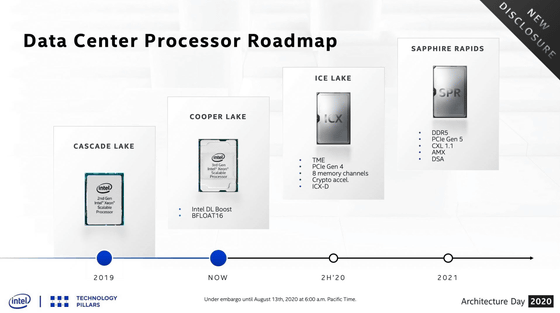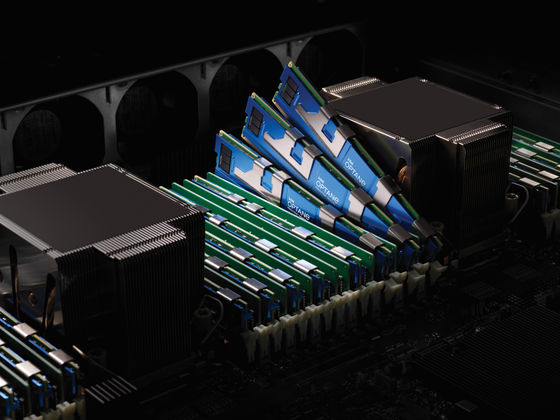Intel's data center CPU 'Xeon' development manager talks about 3rd generation Xeon SP and Optane

On April 6, 2021, Intel
Intel's Full Enterprise Portfolio: An Interview with VP of Xeon, Lisa Spelman
https://www.anandtech.com/show/16608/intels-full-enterprise-portfolio-an-interview-with-vp-of-xeon-lisa-spelman
Over the past few years, Intel has expanded its product lineup for data centers, transforming itself from a CPU-centric company. Products for data centers include the 3rd generation Xeon SP (commonly known as Ice Lake-SP), Optane persistent memory , 200 Gigabit Ethernet, Stratix FPGA , Agilex FPGA , Movidius VPU , and Tofino programmable, which were announced in April 2021. Examples include Ethernet switch ASICs. According to Lisa Spelman, vice president and general manager of Intel's Xeon and Memory Group division, the combination of these products gives Intel the strength of providing solutions that its competitors cannot.
Spelman responded to the question from technology news site AnandTech, 'The Xeon Scalable processors series has met a wide range of needs. Will the new Ice Lake-SP be the same?' , 'We are currently focusing on driving Xeon's network transition from the edge to the cloud. We are enabling the core part of the data center, the cloud, and high-performance computing, and we will continue to serve our customers. We plan to expand the functions and services we can provide to provide a consistent platform for many use cases, 'he said, and is focusing on expanding solutions for data centers.
Intel announces 3rd generation 'Xeon Scalable Processors', adopts 10nm process & greatly improves performance with up to 40 cores --GIGAZINE

'Xeon is the most versatile of all general-purpose solutions, providing the experience of doing literally anything instantly,' Spelman said. It's comprehensive because Intel itself looks at specific areas. It slides to the method of providing a solution, and commented that this slide has significantly improved the requirement collection itself. Examples of comprehensive solutions include Market Ready Solutions for the edge and Select solutions for cloud, enterprise, networking and high performance computing.
'How important is the comparison of raw core performance in the server industry?' Was directed by AnandTech on Xeon's benchmark debate, while Spelman said, 'The preference for benchmarking is the audience. I think that it occupies the core of Spelman College and industry people. I am not going to leave the use of benchmarks, but in addition to 'Benchmark of Xeon CPU alone', 'Benchmark of Xeon platform' I think we should look at it. It's important for Intel to continue to improve overall performance, and standardized benchmarks will continue to be controversial, but a comprehensive 'what can be done across the product line'. I would like to add a new perspective. ' He said that we should look at the 'benchmark of the entire solution'.
In addition, in successive Xeon , the socket was expandable from 1 to 8, but in the 3rd generation Xeon SP, the lineup is Ice Lake-SP with a maximum of 2 sockets in the 10 nm process and Cooper Lake with 4 to 8 sockets in the 14 nm process. Is split. In response to the question, 'Is it split due to technical restrictions or is it due to customer requests?', Spelman replied, 'To give flexibility to the product mix.' Cooper Lake, which was launched earlier, was able to meet a large range of customer requirements, and Ice Lake-SP was able to meet customer needs that the customer himself did not clearly understand. Intel plans to announce Xeon in 2021 with a Sapphire Rapids microarchitecture that integrates Cooper Lake and Ice Lake-SP, but Spelman says it 'covers the entire requirements' at Sapphire Rapids.

When asked, 'I'm probably not going to talk about Sapphire Rapids, so I'd like to ask you what the lifespan of the Ice Lake platform will be.' I think Lake can live, 'Spelman said. Cloud service providers tend to purchase the highest performance products when purchasing products, and of course it is assumed that the highest performance products can be used for a long time, so they intend to meet the needs of 'want to use for a long time'. .. Spelman says, 'Isn't the timing of Sapphire Rapids and Ice Lake too close?', But rather, we'd rather 'build an environment on Ice Lake and then easily switch to Sapphire Rapids.' I'm catching it. '
Intel offers the Optane DCPMM 200 series, which uses the non-volatile memory '3D XPoint' co-developed with Micron, but

Related Posts:
in Hardware, Posted by darkhorse_log







